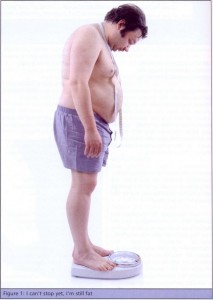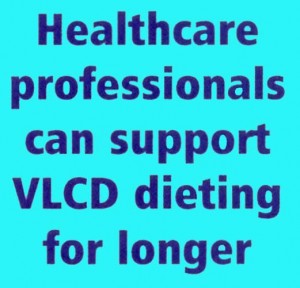S.N Kreitzman Ph.D. R.Nutr. (UK Registered Nutritionist), S. A. Kreitzman, & V. Beeson,
Howard Foundation Research Ltd. Cambridge UK
 The treatment of overweight and obese patients by healthcare professionals is increasingly being recognised as necessary. Unfortunately, the treatment options available have become more and more limited due to serious side effects or lack of sufficient efficacy. Currently in the UK, the major weight loss tools available are essentially limited to either a single drug or invasive surgery (with high morbidity and mortality rates).
The treatment of overweight and obese patients by healthcare professionals is increasingly being recognised as necessary. Unfortunately, the treatment options available have become more and more limited due to serious side effects or lack of sufficient efficacy. Currently in the UK, the major weight loss tools available are essentially limited to either a single drug or invasive surgery (with high morbidity and mortality rates).
In recent years, UK and Irish Pharmacists have been implementing strictly monitored Very Low Calorie Diet protocols, and have demonstrated that non-invasive weight management can be a viable option for healthcare professionals. It is however ironic that the appropriate medical management of obese patients could be potentially disrupted by an arbitrary limitation of use, which interferes with treatment and ultimately restricts the potential medical benefit of the weight loss effort.
It is worth taking a moment to look at some numbers in context.
Obese people (defined generally as those with a BMI above 30) have excess weights greater than 3 stone (roughly 20kg). In examining audit data from 1148 people being treated with Lipotrim at the Prestwich Pharmacy in Manchester, they presented with an average (mean) BMI of 35 and median BMI of 34. Therefore 574 of the 1148 started with a BMI in excess of 34. Ten percent began their diet with morbidly obese BMI’s of greater than 46 and 5% with a BMI over 50. In a separate audit of a further 9071 Lipotrim dieters from pharmacies in the Republic of Ireland, the mean starting BMI was 33 and more than half were over BMI 32. However 10% (more than 900 people) presented to the pharmacy for weight loss at BMI over 41 and over 450 people presented with a BMI in excess of 44. Unfortunately, many patients presenting to GPs have even larger weight problems, almost universally complicated by weight co-morbidities.
Limiting the time allocated for effective treatment is ill advised, just as it would be to withdraw antibiotics before a course is complete. Yet the rhetoric for ending VLCD treatment prematurely has become ritualized, and is often proclaimed without the recognition that it has no
basis whatsoever.
This piece of dietary Urban Legend has its origins over 30 years ago, when an over-zealous company marketed a product which claimed to be a commercial version of Dr George Blackburn’s highly successful ‘Protein Sparing Modified Fast’. Dr. Blackburn’s programme – essentially a home version of a low calorie enteral feed – was based upon a high-quality protein source (generally beef) supplemented with an intelligently constructed micronutrient collection of vitamin and mineral  formulations. The commercial product exploiting his work was dubbed the ‘Liquid Protein Diet’ and promoted in 1976 by a book called The Last Chance Diet. Unfortunately, for many people it proved to be exactly that, as there were many deaths. The Liquid Protein product was an ill-conceived concoction of hydrolyzed cow hide and cherry syrup. It was nutritionally deadly. Banned in the late 1970s, such products bear no relationship to the modern nutrient complete low calorie enteral feeds (now generally called VLCD). Modern VLCD have more than 30 years of documented safe and effective use, and comparing them with the Liquid Protein experience is spurious.
formulations. The commercial product exploiting his work was dubbed the ‘Liquid Protein Diet’ and promoted in 1976 by a book called The Last Chance Diet. Unfortunately, for many people it proved to be exactly that, as there were many deaths. The Liquid Protein product was an ill-conceived concoction of hydrolyzed cow hide and cherry syrup. It was nutritionally deadly. Banned in the late 1970s, such products bear no relationship to the modern nutrient complete low calorie enteral feeds (now generally called VLCD). Modern VLCD have more than 30 years of documented safe and effective use, and comparing them with the Liquid Protein experience is spurious.
When the protein sparing modified fast concept was extended (using proper scientific expertise) into a variety of commercial VLCD products an attemptwas made by one particular company in 1980 to sell it as a mail order product. With the memory of the Liquid Protein disaster still fresh in the public consciousness, the US Postal authorities refused to carry the VLCD unless the retailer agreed to recommend that its use be limited to a period of four weeks. Their logic, not unreasonable for the knowledge at the time, was that even a total fast was perfectly safe for up to 4 weeks. None of the victims of the Liquid Protein experience had problems in less than 8 weeks.
Following more than a decade of worldwide medical study involving several commercial VLCD, one large hospital based programme, limited the programme to 12 weeks of continuous VLCD treatment and used the experience to publish a considerable number of research papers, using data derived from these patients. The 12 week decision was totally arbitrary and there was never any suggestion that harm would have followed from extending the treatment. Protocols from other medical programmes were not constrained. Under the care of health professionals, who recognise that the hazards from weight loss treatment are only related to the impact on existing disease treatments, such as diabetes or hypertension, VLCD can be safe for as long as required, if BMI does not go below the normal range. Weight loss with VLCD in diabetics requires cessation of medication prior to dieting as the diet will normalise blood sugar in days. Weight
loss for people on hypotensive medication requires professional attention, since more than 50% of hypertension is weight related and the treatment must be altered in line with the BP reduction. Weight loss can alter the absorption rate of many drugs and those with a narrow safety spectrum must be monitored carefully. In healthy people, VLCD induced weight loss is benign.
Because of their research papers, and because the product in question became a brand leader, the “12 week” policy adopted in the hospital trials quickly became a common guideline.
The wisdom of interrupting treatment was rarely questioned by committees such as Codex or NICE; they simply accepted it as reasonable. There are many reasons, however, why such an arbitrary recommendation is not wise.
Firstly (and probably least important) is the well documented observation that once interrupted, VLCD is surprisingly difficult to restart. Virtually all of the metabolic adaptations that allow the body to use fat as a fuel (rather than glucose) occur at the start of dieting and ‘dietus interruptus’ is perhaps the most metabolically stressful.
The most important reason, however, can be understood from the audit statistics presented earlier. Twelve weeks is not enough diet time for any obese person’s treatment.
Consider: The average woman is said to be using about 2000 kcal per day. (It can be argued that as she gets heavier and movement becomes more difficult, even this number might be excessive). If no calories at all were eaten by the dieter, the calorie deficit would obviously be 2000 calories per day. To support life, body stores (eventually of fat) would have to provide all of the calories. Obviously, this creates the fastest possible scenario for the utilization of stored fat.
Each pound of fat tissue provides 3500 kcal. Therefore, the maximum weight loss, fasting totally, would be around 1/2 pound per day. In 12 weeks, no more than about 42 pounds of fat can be utilized. This weight loss is insufficient. It would leave the vast majority of obese dieters far short of the achievement of normal weight. Where co-morbidities are being treated by weight loss, there would be a high likelihood of treatment failure.
There is no justification for healthcare professionals who use an effective, noninvasive, dietary treatment for weight management to limit that treatment to some arbitrary time. No evidence for harm exists to warrant terminating treatment, and there is considerable evidence to justify the completion of the treatment. It is time for excathedra comments to be justified with evidence or silenced. •
PDF version: 2-3 NAPC REVIEW 2010 12 WEEKS